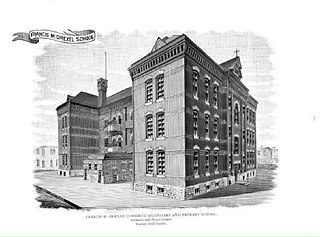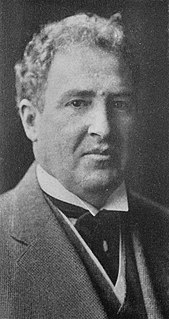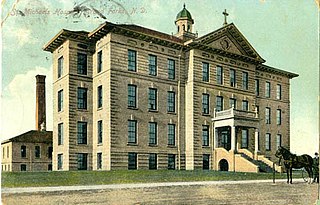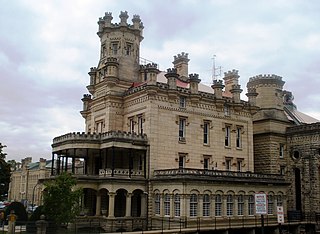Related Research Articles

William LaBarthe Steele was an American architect from Chicago, Illinois. He is considered a principal member of the Prairie School Architectural Movement during the early 20th century.
Purcell & Elmslie (P&E) was the most widely know iteration of a progressive American architectural practice. P&E was the second most commissioned firm of the Prairie School, after Frank Lloyd Wright. The firm in all iterations was active from 1907 to 1921, with their most famous work being done between 1913 and 1921.
Thomas Wilson Williamson was a Kansas architect who specialized in designing school buildings in Kansas, Iowa, and Missouri.
William Augustus Edwards, also known as William A. Edwards was an Atlanta-based American architect renowned for the educational buildings, courthouses and other public and private buildings that he designed in Florida, Georgia and his native South Carolina. More than 25 of his works have been listed on the National Register of Historic Places.

Irwin Thornton Catharine was the chief architect of Philadelphia public schools from 1920 until his retirement in 1937. Buildings built during Catharine's tenure ranged from Gothic Revival, as in the case of Simon Gratz High School, to Streamline Moderne, as in his last project, Joseph H. Brown Elementary School. He died in Philadelphia in 1944.

William Christmas Knighton was an American architect best known for his work in Oregon. Knighton designed the Governor Hotel in Portland, Johnson Hall at the University of Oregon, and the Oregon Supreme Court Building and Deepwood Estate in Salem. He served as Oregon's first State Architect from 1911–1915, appointed by Governor Oswald West. By 1915, Knighton had designed ninety building projects as State Architect. In 1919, Knighton was appointed by Governor Ben Olcott as the first President of the Oregon State Board of Architectural Examiners, a position he held until 1922. In 1920, Knighton was elected the sixth President of the Oregon Chapter of the American Institute of Architects. He remained on the Chapter's Board of the Trustees for several years and was Chair of the Chapter Legislative Committee into the 1930s.

Joseph Anschutz, or Joseph Anshutz, was an American architect who designed schools in the Philadelphia, Pennsylvania area.

John Virginius Bennes was an American architect who designed numerous buildings throughout the state of Oregon, particularly in Baker City and Portland. In Baker City he did an extensive redesign of the Geiser Grand Hotel, designed several homes, and a now-demolished Elks building. He moved to Portland in 1907 and continued practicing there until 1942.

The Richardson L. Wright School was a school in the Nicetown–Tioga neighborhood in northern Philadelphia, Pennsylvania. It was designed by Lloyd Titus, the Chief Draftsman (1901–1905) of the Department of Buildings of the Philadelphia School Board. He was the last non-architect to serve in the position. The school building contained three stories in the Colonial Revival style with a hipped roof. It was destroyed sometime before 2008 and replaced by ball courts.

George Hancock was an architect active in North Dakota, Montana and Minnesota.

Henry deCourcy Richards, also spelled Henry deCoursey Richards, was an American architect who worked in Philadelphia for the public school system. He designed many public school buildings that have since been listed on the National Register of Historic Places for the quality of their architecture.

Cramp & Co. was a building company in Philadelphia. Many of its works are listed on the U.S. National Register of Historic Places. It worked sometimes in conjunction with architect Henry deCourcy Richards.
William R. Dubois (1879-1953) was an American architect. He was a prolific architect in Wyoming and nearby states.
Frank E. Wetherell (1869-1961) was an architect in the U.S. state of Iowa who worked during 1892–1931. He founded the second oldest architectural firm in the state in Des Moines, Iowa, in 1905. He worked with Roland Harrison in partnership Wetherell & Harrison. The firm designed numerous Masonic buildings.

George H. Shanley was an architect of Great Falls, Montana.

William E. Haugaard was an American architect who served as the State Architect for the State of New York from 1928 to 1944. A number of his works have been listed on the National Register of Historic Places.
Frederic Hutchinson "Bunk" Porter, Sr., sometimes referred to as Frederick Hutchinson Porter, was an American architect based in Cheyenne, Wyoming. He was active from 1911 to approximately 1965. He designed many of Cheyenne's most important public and commercial buildings and also designed several buildings at the University of Wyoming, including War Memorial Stadium and the Agriculture Building. A number of his works are listed on the U.S. National Register of Historical Places.
Wallace L. Dow, often known as W.L. Dow, was an architect of Sioux Falls, South Dakota.

William Foster was an architect in Iowa.
William T. Towner was an American architect based in St. Paul, Minnesota.